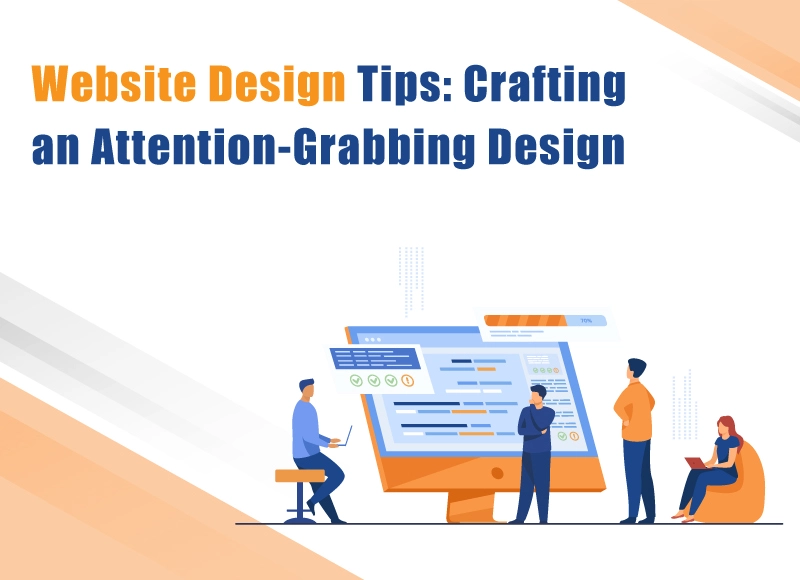- Home
- Blogs
Website Design Tips: Crafting an Attention-Grabbing Design
Want to stand out in the crowded online world? Follow these website design tips to create a visually stunning website that captures your audience's attention.

In today's digital world, website design is essential for businesses to succeed. Having a website that looks good and functions well can help companies attract more customers, increase their revenues and stand out from the competition. Good website design requires an understanding of user experience principles, which are used to ensure visitors have a positive interaction with your website. It also involves using the latest technologies, such as HTML5 and CSS3, to create websites that look great on any device or screen size. By investing in quality website design services, businesses can reap the rewards of having an effective online presence.
How Website Design Can Help Businesses Stand Out
Website design is an essential element of success for businesses in the modern digital age. Businesses can differentiate themselves from their competition by creating a visually appealing and user-friendly website. In addition, having a website design that stands out will increase website traffic and conversions, resulting in increased profits.
Unique Aesthetics
One way website design can help businesses stand out from their competitors is through a unique aesthetic. A website should be able to communicate the company's values and brand identity in an engaging manner that captures visitors' attention. This includes using well-chosen images, colors, fonts, and layouts to create a website that reflects the company's values and personality.
Additionally, website designers should strive to ensure that all website design elements are cohesive and aesthetically pleasing.
Ease of Use Navigation
It is also important to keep users engaged by designing an easy website navigation system. Visitors should be able to find what they need quickly and easily without feeling overwhelmed or frustrated at any point during their visit. A good website design should include intuitive menus, search functions, and clear calls to action throughout the website, encouraging visitors to explore further
and stay longer on sites.
Optimization
Moreover, businesses should aim for optimization when it comes to website design. This means creating websites optimized for all devices, including mobile phones, tablets, and desktops, as well as fast loading – it's crucial if companies want customers to remain engaged with their site rather than heading elsewhere in search of a better experience. Companies can employ various tactics, such as compressing large images or optimizing code to ensure websites load faster, even on low bandwidth connections.
Why Website Design is Essential for Online Stores
Website design is essential for online shopping and e-commerce as it helps create a positive user experience, making customers more likely to purchase. With the rise of internet shopping, website design plays a major role in a customer's first impression of a website. A website that is visually appealing and easy to navigate will draw users in and keep them engaged. In contrast, cluttered website designs with poor navigation will prevent potential customers from leaving without converting.
User Experience
When designing for online shopping or e-commerce sites, website designers should focus on creating an intuitive user experience so that visitors can quickly find what they are looking for and complete their purchases easily. This may include designing website features such as search functions, filters, and sorting options that allow customers to narrow down their options quickly.
Easy to Read
Additionally, website designers should pay attention to typography when creating websites for online shopping and e-commerce sites. Typography is the art of arranging typefaces to convey information visually. Font size, font style, line height, letter spacing, and color all contribute to how readable text is on websites which is crucial for any website related to online shopping or e-commerce, as well as ensuring that visitors can easily understand product descriptions and pricing information.
Security
In addition, website designers should also consider security when crafting website designs for online shopping or e-commerce sites by providing secure payment solutions such as SSL (Secure Socket Layer) encryption technology that encrypts data between customers' web browsers and the server where payments are processed. Furthermore, website designers must ensure customer data remains secure by implementing access control protocols such as two-factor authentication or biometrics which require additional layers of authorization before granting access to sensitive customer information.
Tips for Creating a User-friendly Website
Creating a website that is both user-friendly and visually appealing can be a challenging task for website designers. If you're wondering about how to create a website from scratch, there are several tips you can follow to ensure their website designs meet users' needs and provide them with an enjoyable website experience.
Accessibility
Website designers should prioritize accessibility when designing websites. This means ensuring their website design is accessible to all users regardless of their devices or disabilities, such as limited vision or hearing. Accessibility features such as text alternatives for images, keyboard navigation, high-contrast color schemes, clear, descriptive headings and titles, and adjustable font sizes can help website designers create websites that are accessible to all types of users.
Simplicity
Moreover, designers should also strive for simplicity when it comes to website design. Websites designed with simplicity in mind are typically more attractive to visitors as they are easier to navigate and understand. Therefore, designers should keep the website manageable, which can make it easier for users to find what they're looking for quickly and easily. They should also focus on creating intuitive user interfaces with clear hierarchies so visitors can quickly find what they need without becoming overwhelmed by too many options or pages.
Responsive Design
Furthermore, website designers should also pay close attention to layout when crafting website designs. The layout is the arrangement of elements within a webpage, including the use of whitespace, which enables visitors to differentiate between different parts of the page quickly and easily – it's essential if companies want customers to remain engaged with their site rather than heading elsewhere in search of a better experience. Moreover, website designers should also consider how content will be displayed on different devices, including desktop computers, laptops,
and mobile phones, ensuring images scale properly and text remains readable across devices.
Prototyping
Another important element in creating user-friendly websites is testing designs before launching them live. Testing ensures that any issues related to accessibility or usability have been addressed before the public has access so that any issues can be caught early on and prevent serious problems from arising after launch. Website designers can perform usability reviews by testing websites themselves or enlisting friends or family members who represent different types of users – allowing them to get feedback from multiple perspectives, which can help identify potential issues within the design before launch day arrives.
Search Engine Optimization
To ensure that customers are able to find your website and get the information they need quickly and easily, it's important to incorporate SEO into website design. Search engine optimization (SEO) helps boost website visibility by increasing its ranking on search engines like Google and Bing.
Optimizing website content, images, titles, keywords, descriptions, etc., makes websites more easily discoverable by potential customers looking for related services or products online. Incorporating SEO into website design also ensures that a business stays ahead of the competition and stays up-to-date on changing trends in web development. Therefore, integrating SEO into website design will help companies to attract more customers and increase their revenues.
Conclusion
Website design is essential for businesses to increase website traffic and conversions in today's digital world. By creating a website that is intuitive, accessible, easy to navigate, and eye-catching with the help of website designers, companies can provide customers with an engaging user experience every time they visit their site. This will increase website traffic over time and more conversions, leading to higher revenues overall. Additionally, following these tips while designing websites will ensure businesses stand out from competitors while providing users with exceptional online experiences!

